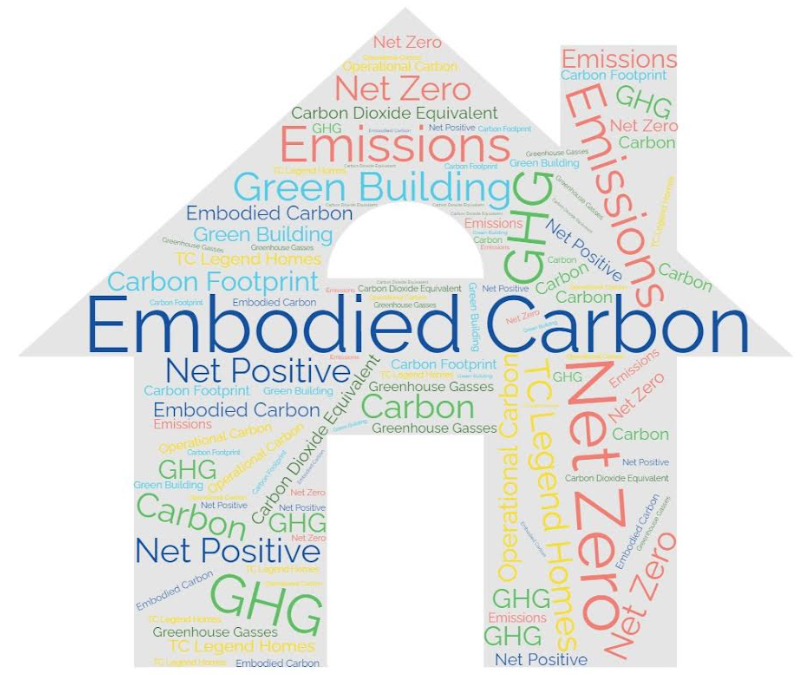
An Introduction to Embodied Carbon
Written by Talia Dreicer
At TC Legend Homes, we have dedicated ourselves to pursing the vision of zero-energy homes for all. We strive to be pioneers in energy efficiency, seeking to create a healthy and clean carbon neutral future that allows the next generation to thrive. Our history of excellence in reducing or eliminating the operational emissions of our homes speaks for itself. Through extensive energy efficiency measures, quality craftsmanship, and a combination of passive solar design and rooftop photovoltaic, we have created a building model that allows us to make our affordable, zero-energy home vision a reality. Over the past 7 years, we have built more than 20 homes and ADU’s that are zero energy ready at a minimum with more than 12 of the 20 being net positive homes. Now it is time for TC Legend to expand our focus to address the other element of emissions in buildings, the embodied carbon.
The carbon footprint of any building is comprised of two elements: the commonly focused upon operational carbon and the less commonly addressed embodied carbon. Since our building model has successfully addressed the operational aspect of this footprint, we are now expanding our focus to addressing the embodied component while still maintaining excellence within the operational emissions.
What is Embodied Carbon and Why does it Matter?
You might ask, “What exactly is embodied carbon and why do we care about it?” Simply put, embodied carbon is the upfront “carbon footprint” of a product. For buildings, you can think of it as the emissions that are produced to create the parts of the building, encompassing all emissions that occur before it is functioning as a home. This includes all emissions from material production and those produced during construction. In contrast the operational carbon of a home is the emissions released to heat, cool, and electrify the home over its lifetime.
Figure 1: Carbon Foot Print Formula

Since embodied carbon emissions are “stored” in the home before it is operating, the embodied carbon sets the baseline for the total footprint of the home. Even if a house is exceptionally efficient, producing little to no operational emissions, the total carbon footprint of the house is not zero because of the upfront emissions. This is why embodied carbon matters. If we solely focus on operational carbon and the future emissions of the home, we do not consider the significant portion of emissions being released NOW. And, according to the 2022 Intergovernmental Panel on Climate Change (IPCC) report, drastically reducing emissions now is what will have the greatest impact on avoiding the most severe elements of climate disaster. For years, scientists have warned of the catastrophic results to the climate and environment if the world reaches an average temperature of 1.5-2° C above prehistoric levels. The 2022 IPCC report notes that we are on a trajectory to reach the 1.5° C in the next two decades, highlighting the only way to stop this impending disaster is to focus on emission on the today-10 year timeline. Since the majority of building emissions occurring in the first 10-15 years of a highly efficient or zero-energy home are embodied emissions, these need to be our focus moving forward. While we do not want to give up operational efficiency, we need to focus on reducing the embodied carbon emissions that are produced now, and work to reduce the overall emissions of our buildings.
The below graphs illustrate how a reduction in the embodied carbon has a significant impact on the total emissions of a home on the ten year time horizon, given that the majority of emissions on this time scale are from embodied carbon. House #1 and House #2 demonstrate two houses with the same design, producing similar operational emissions. However, if we are careful in selecting materials with lower embodied carbon, we can see a significant difference in the total emissions of a house, as demonstrated by the house #2 graph. These two graphs illustrate a high efficiency home designed without a focus on embodied carbon (house #1) vs one where there is attention given to reducing embodied carbon (house #2).
Figure 2: Total Emissions of a Home on the Ten Year Time Horizon
Our Objective
As a company that strives to create a healthy future for all, it is our responsibility to do our part in the next 10 years. By expanding our focus to better address our homes “now” emissions through modeling and decreasing our embodied carbon, we are working to be part of the necessary change. Tackling the biggest issues and working to refine our model to achieve excellence in both areas of home emissions is our newest goal, and one we hope that through education of the public and adjustment without our own building model, we can help lead the building industry in the right direction.
We will share additional posts on the topic of embodied carbon with more details on what embodied carbon is, how its calculated, and how we are making changes in the coming weeks so stay tuned!
Recent Comments